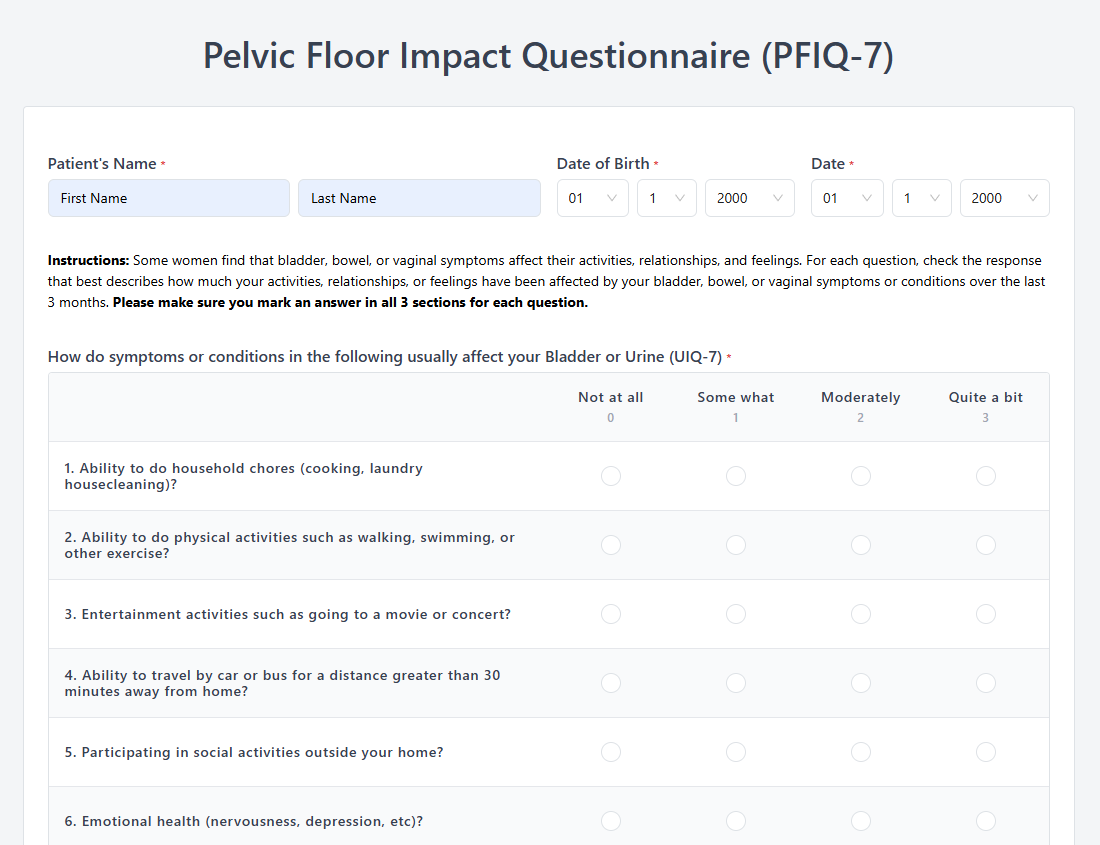

The Pelvic Floor Impact Questionnaire (PFIQ-7) is a vital tool used to evaluate how pelvic floor disorders affect a patient’s quality of life. Designed for use in urogynecology, pelvic rehabilitation, and physiotherapy settings, it provides a concise yet comprehensive measure of functional impact and daily limitations. Zentake’s HIPAA-secure digital version modernizes how clinics collect and analyze this data, helping healthcare professionals save time, reduce paperwork, and improve accuracy through automation and secure online workflows.
The PFIQ-7 is a validated, patient-reported outcome measure developed to assess the impact of pelvic floor disorders (PFDs) — including pelvic organ prolapse, urinary incontinence, and fecal incontinence — on women’s daily lives. Created by Barber et al. as part of the Pelvic Floor Disorders Network (PFDN), the PFIQ-7 condenses the longer Pelvic Floor Impact Questionnaire into a 7-item format for faster, yet equally reliable, evaluation.
Each of the seven items measures how pelvic floor dysfunction affects daily, social, and emotional activities. It is scored to determine the degree of impairment in three domains: urinary, colorectal-anal, and prolapse symptoms.
Clinicians often use the PFIQ-7 to monitor symptom changes before and after interventions such as surgery or physical therapy.
The PFIQ-7 is more than a form — it’s a crucial instrument for understanding the lived experience of pelvic dysfunction. It bridges the gap between clinical symptoms and patient perception, allowing providers to make informed treatment decisions.
For clinicians, it delivers quantifiable insight into how symptoms influence physical and emotional well-being. For patients, it offers a simple, confidential platform to communicate personal experiences that may not be apparent during clinical examinations.
The PFIQ-7’s brevity makes it ideal for busy clinical environments without compromising diagnostic value.
Traditional paper-based PFIQ-7 forms often lead to manual data entry errors, misplaced records, and delays in analysis. In contrast, Zentake’s digital PFIQ-7 form automates every step — from patient completion to data storage — ensuring a faster, safer, and more reliable process.
With Zentake, patients can securely complete the questionnaire on any device, while healthcare staff receive structured data automatically synced to their systems. Instead of manually tallying scores or filing papers, results are instantly accessible through Zentake’s centralized dashboard. This automation not only eliminates administrative inefficiencies but also enhances accuracy and patient satisfaction.
Imagine this scenario:
Before Zentake, clinic staff had to print, distribute, and manually encode each PFIQ-7 response. After adopting Zentake, patients receive the form via secure links, results are scored automatically, and clinicians can review trends at a glance — all while maintaining HIPAA compliance and audit trails.
Zentake redefines how healthcare organizations handle the PFIQ-7 and similar assessments. Its digital-first platform simplifies every stage of data collection, scoring, and management while upholding the highest standards of security, accuracy, and compliance.
Adopting a digital version of the PFIQ-7 can be seamless when paired with effective workflow planning. Here are practical strategies to ensure smooth implementation:
Clinics adopting Zentake report up to 40% faster workflows and significant reductions in administrative overhead. With secure audit trails, digital signatures, and automated compliance checks, Zentake also helps organizations maintain regulatory readiness without manual oversight.
Q1. Who can use the PFIQ-7?
The PFIQ-7 is suitable for urogynecologists, pelvic health physiotherapists, rehabilitation specialists, and researchers evaluating the functional impact of pelvic floor disorders.
Q2. How long does it take to complete the PFIQ-7?
It typically takes under five minutes, whether completed digitally or in person. Zentake’s digital format allows patients to complete it from any device, at their convenience.
Q3. Is the PFIQ-7 scientifically validated?
Yes. The PFIQ-7 is a validated and widely recognized assessment developed by the Pelvic Floor Disorders Network and published in peer-reviewed medical literature.
Q4. Can Zentake integrate with EHR systems?
Absolutely. Zentake supports direct EHR integrations, allowing seamless data synchronization and reducing manual input.
Q5. How do I export or share results securely?
Zentake allows encrypted exports in PDF or CSV formats. Access controls ensure only authorized staff can view or share patient data.